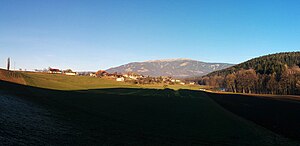Unterpichling
|
Unterpichling ( village ) locality |
||
|---|---|---|
|
|
||
| Basic data | ||
| Pole. District , state | Wolfsberg (WO), Carinthia | |
| Judicial district | Wolfsberg | |
| Pole. local community | St. Georgen in the Lavant Valley | |
| Coordinates | 46 ° 43 '15 " N , 14 ° 52' 30" E | |
| height | 420 m above sea level A. | |
| Residents of the village | 47 (January 1, 2020) | |
| Primaries | + 43/43 57 | |
| Statistical identification | ||
| Locality code | 03066 | |
 View from the southwest, in the background the Koralpe |
||
| Source: STAT : index of places ; BEV : GEONAM ; KAGIS | ||
Unterpichling is a village in the municipality of St. Georgen im Lavanttal in the Wolfsberg district in Carinthia ( Austria ).
There are 47 people (as of January 1, 2020) living in this small village in the south of the Lavant Valley. The small town became known nationally and even internationally as Austria's only “non-smoking village”. Between 1997 and 2000, ORF and ProSieben produced a television report, and the Austrian weekly News reported on it.
history
In 1255, Count Siegfried von Pfannberg gave a farm ("some Pfannberg possessions in Lavantthale") in Puhelarn and another near Entresdorf ( Andersdorf ) to St. Paul Abbey under Abbot Leutold . Puhelarn inferius ("inferius" is Latin for "below"), then Unter-Bichling am Ragglbache (as mentioned in Archives for Austrian History , Volume 18 from 1857) and is called Unterpichling today.
Geographical location
Unterpichling is located between St. Paul , Maria Rojach and St. Georgen in the Lavant Valley . The Ragglbach flows from Eisdorf coming to the southwest direction over Allersdorf. To the east of the village is the Pichlinger Kogel ( 522 m ), which is mainly covered with coniferous forest.
economy
The village's farms produce milk, bread, eggs, fruit, cattle and pigs, as well as apple juice and cider. A carpentry has been run as a family business since 1958, employing over 10 people.
